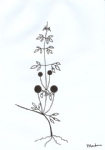Clematis Montana Group
Origin: Cultivars are derived from the botanical Section Montana, from species like Clematis montana and Clematis gracilifolia.
Name: An old Group well established by Moore & Jackman in 1872 without any question about the choice of name and fully recognized by Whitehead in 1959.
Habit: Climbing, some of the most recent cultivars are less rampant in growth to semi-climbing, deciduous.
Leaf: Ternate or pinnate, glabrous to densely yellowish hairy, herbaceous, petioled. Leaflets simple, margin entire, serrate or lobed.
Inflorescence: Solitary flowers. On young shoots flowering from the base upwards.
Bracts: No bracts.
Flower: Unisexual or bisexual, spreading, upright, 3-10 cm across, bud nodding.
Tepals: 4(-5-6), white or shades of red-purple.
Stamens: Usually present but in unisexual cultivars absent, filaments glabrous.
Pistil: Normally fertile but in some cultivars changed into tepal-like pistillodes.
Flowering time: Spring and/or sometimes in summer.
Seed tail: plumose, seedhead not persistant.
Zone: (5-6-)7-9 (EU & USDA zones).
Pruning only when necessary and then after flowering at 2-3 meter above soil level.
Planting depth: Same level as in the pot, do not plant deeply.
Roots: Fibrous.
Leaves in seedlings: Alternate.
ref: Wim Snoeijer (2008) Clematis Cultivar Group Classification with Identifying Key and Diagrams.
Back to group list

